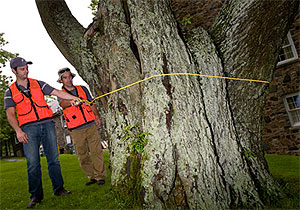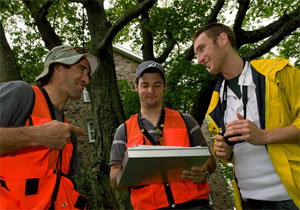 |
| Charles Harrington and Matt Follett measure the circumference of the massive Red Oak behind Sherriff Hall. (Bruce Bottomley Photo) |
The Red Oak was well established when Edward Cornwallis arrived on Halifaxās shores in 1749, and already impressive when George Ramsay, the ninth Earl of Dalhousie, decided to establish a college in Halifax in the early 19th century.
Looking a bit like the Whomping Willow described in the Harry Potter books, Quercus rubra has a trunk that measures 167 centimetres in diameter and is more than 19 metres tall. Located behind Sherriff Hall, its massive canopy shades the sidewalk on Oxford Street.
Arborist Matt Follett estimates the treeās vintage at 300 years, perhaps more. Thought to be Dalhousieās oldest tree, it was one of the more interesting things discovered so far in the course of doing a ānatural inventoryā for Dalhousieās Office of Sustainability.
OtherĀ noteworthy finds: a grove of mature oaks situated behind the Life Sciences Centre, a patch of blueberries (but no oneās saying exactly where) and, from the Magnolia family,Ā a recently planted tulip tree (Liriodendron tulipifera), a species rarely seenĀ in Nova Scotia.
 |
| Matt Follet is the arborist leading the natural inventory, with help from Charles Harrington and Christopher Boyle. (Bruce Bottomley Photo) |
āWeāre taking a look at the trees we have on the grounds of pilipiliĀž» in an effort to understand what we have and what we should do to improve,ā says Mr. Follett, an environmental science student and self-described ātree guyā who is working on the inventory with Christopher Boyle, a masterās student in resource and environmental management, and Charles Harrington, an engineering grad.
While Dalhousieās campuses areĀ known forĀ their ivy-covered buildings, beautiful tree-lined avenues and flower gardens, the project workers believe they could be better with more diversity of planting and especially more native species.Ā Perhaps, they muse,Ā there could be gardens for food production or natural areas developed for outdoor classrooms.
But first they have to assess what the university has now: theyāre doing that by counting the trees, making note of what kind they are, and taking measurements of their trunks and canopies and determining height. The information will also determine the amount of carbon dioxide being offset by the trees.
āItās a way to get a handle on our greenhouse gases,ā explains Rochelle Owen, director of the Office of Sustainability. āTrees arenāt just for nice aesthetics; they have incredible economic attributes.ā
In the winter, trees can also reduce the energy needed to warm campus buildings. Windbreak trees can reduce the energy required by 10 to 15 per cent.
In the summer, trees that are suitably sited can reduce cooling costs from 15 to 50 per cent. They shade buildings and streets and their leaves cool the air around them by evaporating huge quantities of water drawn up from the roots in the ground.
It is expected to take most of the summer to complete the inventory. Once complete, the project workers will make recommendations in terms of new plantings, where they should go and what they should be.
DISCUSSION: What kinds of things would you like to see to enhance the natural environment on campus?
